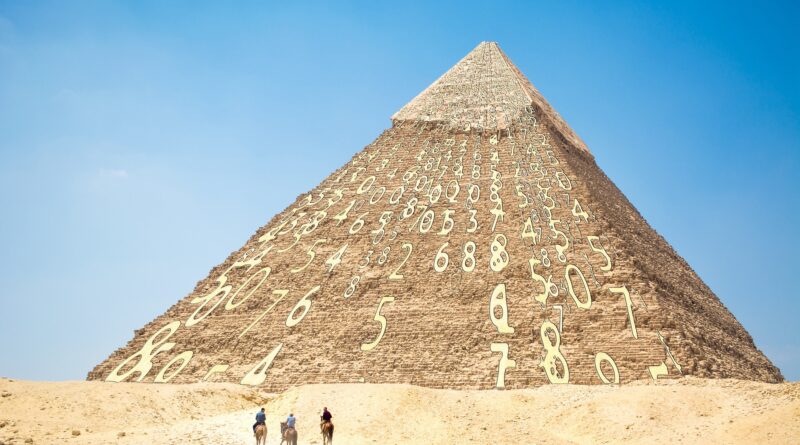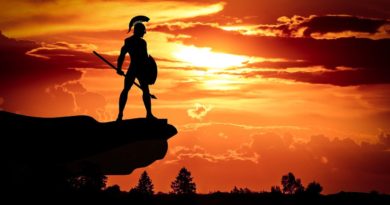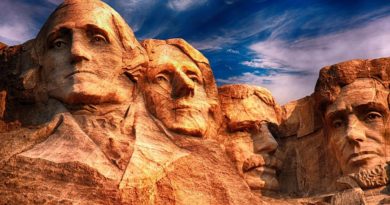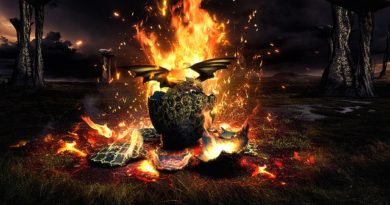Ancient Aliens
By Derek P. Gilbert, Host of SkyWatch TV
With popular shows such as Ancient Aliens promoting the belief that ancient gods were just misidentified extraterrestrials, mistaken for gods by the men who met them, the world is now very familiar with the Ancient Astronaut Theory. Many ancient texts, especially those from the ancient near-east, are used to support this claim. Among the most used are ancient Sumerian, Babylonian, and Jewish texts.

However, there are certain inconsistencies found within those texts which do not seem to promote Ancient Astronaut Theory. For example, in the creation mythology of Baal, the gods existed in a watery abode. Ancient Astronaut theorists might be tempted to think of this as a water-world exoplanet. If this were the case, and if these alien gods communicated with mankind, we should expect beliefs around those communications to develop within their culture and religion. Why is it, then, large bodies of water such as the sea were more closely related to concepts of chaos and death in these belief systems? If alien creator gods came from water-worlds, shouldn’t the seas of Earth represent life rather than death? A closer look at the ancient texts themselves can provide us a clearer picture of the whole story.

The Enuma Elish is the Babylonian epic of creation, also known as The Seven Tablets of Creation. All the tablets containing the creation myth were found at Ashur, Kish, Nineveh, Sultante, and other excavated sites. The tablets date to about 1100 BC but there are indications that they’re copies of a much older version of the story. The myth describes the birth of the gods, the universe, and human beings. In the beginning, according to the story, there was nothing else except chaotic water everywhere. Out of the movement of the water, the waters divided into fresh and salt water. The fresh water is identified as the god Apsu while the salt water is identified as the goddess Tiamat. Through these two entities came the birth of younger gods.
The younger gods were noisy and troubling Apsu, so upon the advice of Mummu, Apsu decides to kill the younger gods. Tiamat hears of this and warns her eldest son, Enki (sometimes Ea), so he puts Apsu into a sleep and kills him. Enki then creates his home from Apsu’s remains. Tiamat becomes angry over Apsu’s death and consults with Quingu, who advises her to bring war against the younger gods. Tiamat gives Quingu the Tablets of Destiny, which solidifies the rule of a god. Quingu wears the tablets as a breastplate. Tiamat then summons the forces of chaos and creates eleven monsters to destroy the younger gods.
🔮 Pre-order your copy today from leading bookstores and online retailers! 🔮
Ea/Enki and the other younger gods fight against Tiamat, but are unable to win the battle until Marduk emerges as a champion among them. Marduk defeats Quingu and kills Tiamat by shooting her with an arrow, splitting her in two. Marduk creates the heavens and the earth from Tiamat’s corpse (half to make the heavens, half to make the earth). He then appoints jobs to the younger gods and binds Tiamat’s eleven monsters to his feet as trophies. He then takes the Tablets of Destiny from Quingu, thereby solidifying his reign.
Marduk then talks with Ea, recognized as the god of wisdom, and decides to create human beings. He does this by killing the gods who convinced Tiamat to go to war. Quingu is found guilty and killed. Ea creates Lullu, the first man, from the blood of Quingu. Lullu’s job is to help the gods in their task of maintaining order and keeping chaos restrained. The story then ends with a long praise of Marduk for everything he did. The entire story is about chaos being subdued by the destruction of a great sea beast.
In other words, the sea beast is a symbol for chaos.
A similar story can be found in the Ugaritic Baal Cycle. Ugarit was an ancient city, located at what is now Ras Shamra in northern Syria.
In the second millennium BC, the population of Ugarit was Amorite and would have controlled roughly 2,000 square kilometers on average. During some of its history, Ugarit would have been directly within, or at least in close proximity to, the Hittite Empire.

Ugarit was destroyed in the early 12th century BC and its location forgotten until 1928 when a peasant accidentally discovered an old tomb. The area of the tomb was found out to be the necropolis of Ugarit. Excavations have since revealed a city with a prehistory reaching back to c. 6,000 BC.
Archaeologically speaking, Ugarit is considered Canaanite. Arguably, the most important literary document recovered from Ugarit is the Baal Cycle, which describes the basis for the belief system surrounding the Canaanite deity Baal. In fact, Ugarit bordered the northern Israelite kingdom and can be considered the center of ancient Baal worship. Of further importance is the discovery of the Ugaritic language, which is closer to biblical Hebrew than any other Semitic language. There are extremely interesting word-for-word parallels between Ugaritic myths and passages in the Old Testament which show clear polemics (controversial arguments intended as an attack on a differing belief or idea). As we will explore a bit later, we can read the creation account in the Bible and see a polemic to the Baal Cycle.
The Baal Cycle isn’t as much about creation as it is a competition between gods to win a position of rulership with the supreme god El. It describes a battle between Baal (meaning “lord”) and Yam (meaning “sea”), and another battle between Baal and Mot (meaning “death”). Yam is also called Nahar (meaning “river”) and is also described as a sea monster with seven heads named Litanu (the Canaanite word for ‘Leviathan”). In the Baal Cycle, Yam is a symbol for the sea and the forces of chaos, comparable to Tiamat in the Enuma Elish. Baal defeats Yam and is declared king of the other gods, yet still under El. He is given the titles “the Rider on the Clouds,” “Most High,” and is described as having everlasting dominion.
To a person in the ancient Near East, the sea was considered extremely dangerous, chaotic, and even otherworldly. The sea is untamable, unpredictable, and wild. Sea creatures themselves were considered symbolic portrayals of the place in which they lived: the sea. This is the reason we see the symbol of the sea and a great sea beast/monster/dragon repeated in the religious texts of the ancient near-east. To those people, there was no better representation for death and chaos. We even see this idea turn up in the Bible.
We are at least two thousand years and half a world removed from the ancient Jewish culture in which much of the Bible was written. The best way to understand and interpret the Bible is to put yourself in the ancient writer’s shoes. What was going on at the time of the writing? What was the writer dealing with in terms of competing theologies? What was the cultural environment of that time? By asking these questions and looking at the text through ancient Near Eastern eyes, we can gain a better understanding of the scriptures.
This brings us back to the idea of polemic. As stated briefly earlier, a polemic is a type of theological jab at a different religion or belief. These show up all over the texts in the Bible. The idea was not always to give a literal account of something, but to attribute credit to the true God of Israel, YHWH. For example, we find in the Baal Cycle the term “Rider on the Clouds” is attributed to Baal. Yet, we read a response to that claim throughout the Bible as YHWH is referred to in the same way. Even Jesus Christ referred to Himself in this manner. The point was not to describe the oddity of God riding on clouds; it was to state that Baal was not the one in charge. It is a deliberate swipe at the belief of Baal having everlasting dominion by taking his title and attributing it to the true God, YHWH.
This is only one example of a polemic in the Bible. There are many others.
Some of the most interesting polemics can be found in the creation accounts of the Bible. The idea of polemic will also help explain some different descriptions between these creation accounts. For example, we can compare Genesis 1:1-3 with Psalm 74:12-17.
1 In the beginning, God created the heavens and the earth. The earth was without form and void, and darkness was over the face of the deep. And the Spirit of God was hovering over the face of the waters. And God said, “Let there be light,” and there was light. (Gen. 1:1–3, ESV)
Yet God my King is from of old, working salvation in the midst of the earth. You divided the sea by your might; you broke the heads of the sea monsters on the waters. You crushed the heads of Leviathan; you gave him as food for the creatures of the wilderness. You split open springs and brooks; you dried up ever-flowing streams. Yours is the day, yours also the night; you have established the heavenly lights and the sun. You have fixed all the boundaries of the earth; you have made summer and winter. (Ps. 74:12–17, ESV)
Here, we have two very different sounding accounts. In Genesis, we learn God created the heavens and the Earth; the Earth was without form and void; there was darkness over the face of the deep; the Spirit of God was hovering over the waters; and then God began His creation by creating light.

🔮 Pre-order your copy of Revelation 911 today!
The account in Genesis establishes the conflict between God and primordial chaos, represented by the sea and a sea monster, in the very second verse of the Bible. The word translated “deep” is the Hebrew tehom. That’s a cognate—same word, different language—to the Akkadian têmtum, which in turn is a variant form of Tiamat, the Sumerian name for the chaos monster of the sea.
Why did the Spirit of God hover over the waters? Although there is no record here of the conflict between YHWH and “the deep,” it appears the intent was to restrain something—chaos itself.
Derek P. Gilbert hosts Five in Ten, a daily analysis of the news for SkyWatchTV, and co-hosts the weekly programs The Bible’s Greatest Mysteries and Unraveling Revelation with his wife, author, and analyst Sharon K. Gilbert. Derek is a Christian, a husband and father, and the author of the groundbreaking books Bad Moon Rising, an analysis of the spiritual forces behind Islam, The Great Inception, and Last Clash of the Titans. He’s also the co-author with Sharon K. Gilbert of Giants, Gods & Dragons, a new take on end-times prophecy that names the Four Horsemen of the Apocalypse, and Veneration, a deep study on the ancient cult of the Rephaim. Derek has also co-authored The Day the Earth Stands Still with Josh Peck, which documents the occult origins of “ancient aliens.” Derek’s new book is The Second Coming of Saturn, which exposes the many faces of the Roman god Saturn and his role during the end times. Find out more at www.derekgilbert.com, www.gilberthouse.org, or www.SkyWatchTV.com.





